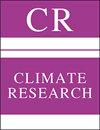Envisioning the future in the light of climatic and non-climatic riskscapes: lessons from KwaZulu-Natal, South Africa
IF 1.6
4区 地球科学
Q4 ENVIRONMENTAL SCIENCES
引用次数: 0
Abstract
ABSTRACT: The concept of a ‘Riskscape’ serves as a proactive framework intertwining risk, geographical space, and human practices. It sheds light on how diverse stakeholders perceive phenomena and take action to navigate the future and address emerging risks. This study applies the riskscape concept to comprehend the impact of climate change, coupled with non-climatic risks, on vulnerable households in KwaMaye village, rural KwaZulu-Natal (KZN), South Africa. The research also explores how local farmers envision their future amidst the prevailing conditions. Qualitative methods were employed to gather primary data from purposefully selected participants in KwaMaye. The findings reveal that climatic risks contributing to households’ vulnerability include droughts, heavy rainfall, and flooding, among other factors. Non-climatic risks emanate from issues such as an increasing livestock population, diminishing grazing fields, and delays in provincial government assistance. The convergence of climatic and non-climatic risks forms riskscapes that significantly impede most households’ ability to engage effectively in livestock and food production. This is partly due to the lack of nutritious pastures during droughts. In response to the scarcity of nutritious pastures during extreme droughts, resource-constrained farmers resort to illegally accessing nearby commercial irrigated farmlands to allow their livestock to forage. However, this action carries a substantial fine if they are caught. Despite the challenges, respondents express reluctance to reduce their livestock numbers in the face of frequent droughts. However, many argue that they may be compelled to abandon food production if the issues related to these riskscapes are not promptly addressed.根据气候和非气候风险景观展望未来:南非夸祖鲁-纳塔尔省的经验教训
ABSTRACT: "风险景观 "的概念是一个将风险、地理空间和人类实践交织在一起的前瞻性框架。它揭示了不同的利益相关者如何感知各种现象,并采取行动引领未来和应对新出现的风险。本研究运用风险景观概念来理解气候变化以及非气候风险对南非夸祖鲁-纳塔尔省(KZN)农村地区 KwaMaye 村弱势家庭的影响。研究还探讨了当地农民如何在当前条件下展望自己的未来。研究采用定性方法,从 KwaMaye 特意挑选的参与者那里收集原始数据。研究结果显示,导致家庭脆弱性的气候风险包括干旱、暴雨和洪水等因素。非气候风险来自于牲畜数量增加、牧场减少以及省政府援助延迟等问题。气候风险和非气候风险交织在一起,形成的风险景观严重阻碍了大多数家庭有效从事畜牧业和粮食生产的能力。部分原因是干旱期间缺乏有营养的牧场。为了应对极端干旱期间营养牧场的匮乏,资源有限的农民会非法进入附近的商业灌溉农田,让牲畜觅食。然而,这种行为一旦被发现,将被处以巨额罚款。尽管面临这些挑战,受访者仍表示不愿在干旱频发的情况下减少牲畜数量。然而,许多人认为,如果与这些风险景观相关的问题得不到及时解决,他们可能会被迫放弃粮食生产。
本文章由计算机程序翻译,如有差异,请以英文原文为准。
求助全文
约1分钟内获得全文
求助全文
来源期刊

Climate Research
地学-环境科学
CiteScore
2.90
自引率
9.10%
发文量
25
审稿时长
3 months
期刊介绍:
Basic and applied research devoted to all aspects of climate – past, present and future. Investigation of the reciprocal influences between climate and organisms (including climate effects on individuals, populations, ecological communities and entire ecosystems), as well as between climate and human societies. CR invites high-quality Research Articles, Reviews, Notes and Comments/Reply Comments (see Clim Res 20:187), CR SPECIALS and Opinion Pieces. For details see the Guidelines for Authors. Papers may be concerned with:
-Interactions of climate with organisms, populations, ecosystems, and human societies
-Short- and long-term changes in climatic elements, such as humidity and precipitation, temperature, wind velocity and storms, radiation, carbon dioxide, trace gases, ozone, UV radiation
-Human reactions to climate change; health, morbidity and mortality; clothing and climate; indoor climate management
-Climate effects on biotic diversity. Paleoecology, species abundance and extinction, natural resources and water levels
-Historical case studies, including paleoecology and paleoclimatology
-Analysis of extreme climatic events, their physicochemical properties and their time–space dynamics. Climatic hazards
-Land-surface climatology. Soil degradation, deforestation, desertification
-Assessment and implementation of adaptations and response options
-Applications of climate models and modelled future climate scenarios. Methodology in model development and application
 求助内容:
求助内容: 应助结果提醒方式:
应助结果提醒方式:


